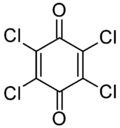 | |
| Names | |
|---|---|
| IUPAC name 2,3,5,6-Tetrachlorocyclohexa-2,5-diene-1,4-dione | |
| Other names p-Chloranil; Tetrachloro-1,4-benzoquinone; Tetrachloro-p-benzoquinone | |
| Identifiers | |
3D model (JSmol) | |
| ChEBI | |
| ChEMBL | |
| ChemSpider | |
| ECHA InfoCard | 100.003.887 |
| EC Number |
|
| KEGG | |
PubChem CID | |
| RTECS number |
|
| UNII | |
CompTox Dashboard (EPA) | |
| |
| |
| Properties | |
| C6Cl4O2 | |
| Molar mass | 245.86 g·mol−1 |
| Appearance | Yellow solid |
| Melting point | 295 to 296 °C (563 to 565 °F; 568 to 569 K) |
| −112.6·10−6 cm3/mol | |
| Hazards | |
| GHS labelling: | |
  | |
| Warning | |
| H315, H319, H410 | |
| P264, P273, P280, P302+P352, P305+P351+P338, P321, P332+P313, P337+P313, P362, P391, P501 | |
Except where otherwise noted, data are given for materials in their standard state (at 25 °C [77 °F], 100 kPa). | |
Chloranil is a quinone with the molecular formula C6Cl4O2. Also known as tetrachloro-1,4-benzoquinone, it is a yellow solid. Like the parent benzoquinone, chloranil is a planar molecule [2] that functions as a mild oxidant.